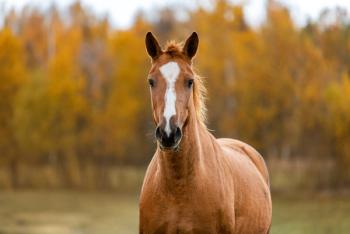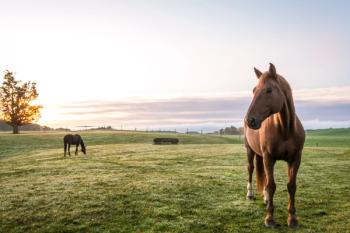
Equine herpes outbreak eases; officials say quarantine efforts limited greater risk
National Report - Intense monitoring by veterinarians and quick action by the equine industry helped contain a multi-state equine herpesvirus (EHV-1) outbreak that could have spiraled out of control.
NATIONAL REPORT — Intense monitoring by veterinarians and unilateral action by the equine industry helped contain a multi-state equine herpesvirus (EHV-1) outbreak that could have spiraled out of control, experts say.
There have been no cases of EHV-1 jumping into the general horse population, says Dr. Jerry Black, but only in horses that attended a Utah cutting horse competition or were in direct contact with those that did.
The first case in the outbreak, which infected a total of 91 horses across 11 Western states as of mid-June, was discovered May 11, just after the National Cutting Horse Association's (NCHA) Western National Championships in Odgen, Utah ended on May 8.
"The economic impact to the industry has been horrendous, but I must say I am very proud of all the calls that were made," says Black, director of the Equine Sciences Program at Colorado State University, a member of the National Cutting Horse Association (NCHA) executive committee, and trustee on the American Horse Council representing the American Association of Equine Practitioners. "It's always been about the welfare of the horses."
In his 40 years as an equine veterinarian and 30 years in the cutting horse industry, Black says this is the first major EHV-1 outbreak he has seen that originated at a public event and wasn't discovered until after all the horses had gone home. Shutting down the industry and stopping the movement of horses was critical to getting the outbreak under control, he says.
"It saved us from having a major problem," Black says.
The infected horse had been overnighted in Utah, and then went on to a show in Bakersfield, Calif. It arrived at the show febrile and was showing severe neurologic signs by the next morning.
"My involvement began that day," says Black.
The horse had to be euthanized, and Black consulted with event organizers of an upcoming cutting horse event, who ultimately decided to cancel the show. Immediately after that, positive EHV-1 test results came in on the euthanized horse.
But another event in Tulsa was on the horizon. Horse owners who were at Ogden were warned not to come, but organizers became concerned that trailers and equipment that had been in Ogden could still surface in Tulsa and bring the virus with them, Black explains. The event was cancelled, even though many participants had already arrived.
In the weeks that followed, the outbreak quickly spiked, then began to wither. In mid-May, there were an initial 12 confirmed cases in California and Colorado. Colorado State University's and Washington State University's veterinary teaching hospitals both initiated voluntary quarantines at the onset of the outbreak to limit the spread of the virus. Both hospitals have since lifted restrictions on equine cases.
Some state veterinarians issued orders limiting equine movement, and all states that had horses attend the Utah event monitored them for signs of the disease.
Still, by mid-June, a total of 91 infections had been confirmed in 11 Western states, according to the United States Department of Agriculture's Animal and Plant Health Inspection Service (APHIS) and state veterinary officials.
Some of the horses affected by the outbreak became infected with the neurological form of the disease, equine herpesvirus myeloencephalopathy (EHM), which can present with symptoms such as nasal discharge, lack of coordination, hind-end weakness, lethargy, urine dribbling and diminished tail tone.
Horse owners were urged to notify veterinarians if they participated in the NCHA event or if their horse suddenly came down with a temperature above 102-degrees-F, which typically precedes more severe clinical signs. Treatments for EHV-1/EHM include intravenous fluids, anti-inflammatory drugs and other appropriate supportive treatment, but authorities suggested immediate separation and isolation of identified suspect cases and implementation of appropriate biosecurity measures as a means to control the spread of the disease.
As of June 16, of the 91 total confirmed cases of EHV-1/equine herpesvirus myeloencephalopathy (EHM), 55 of the infected horses had attended the Utah cutting horse event.
In the week before June 16, EHV-1 primary exposures totaled 28 and EHM primary cases were at 26 total.
EHV-1 secondary cases outnumbered the primary cases at 29, and EHM cases totaled seven cases, APHIS reports. Not included in APHIS' count was a confirmed EHV-1 primary case in a horse showing no clinical signs, reported June 11 by the Montana Department of Livestock.
Overall, more than 400 horses in 19 states were exposed to the virus at the Utah event, and another 1,685 have been exposed by association, APHIS says. In addition, 13 horses either died or were euthanized as a result of this outbreak.
Several state veterinary officials reported that they planned on monitoring secondary exposure cases until June 5. While the incubation period for EHV-1 is two to 14 days, the virus can shed up to 28 days, veterinarians say.
As of June 16, total confirmed cases in the outbreak were:
- Arizona — 2 EHV-1 and 1 EHM from direct exposure, 10 EHV-1 and 1 EHM from secondary/tertiary exposure;
- California — 9 EHV-1 and 7 EHM from direct exposure, 5 EHV-1 and 1 EHM from secondary/tertiary exposure;
- Colorado — 9 EHV-1 and 6 EHM from direct exposure, 1 EHV-1 from secondary/tertiary exposure;
- Idaho — 1 EHV-1 and 2 EHM from direct exposure, 3 EHV-1 and 2 EHM from secondary/tertiary exposure;
- Montana — 1 EHV-1 from direct exposure;
- Nevada — 1 EHV-1 from direct exposure, 2 EHM from secondary/tertiary exposure;
- New Mexico — 2 EHV-1 and 1 EHM from direct exposure, 1 EHM from secondary/tertiary exposure;
- Oklahoma — 1 EHM from direct exposure;
- Oregon — 2 EHV-1 and 1 EHM from direct exposure, 2 EHM from secondary/tertiary exposure;
- Utah — 1 EHV-1 and 4 EHM from direct exposure, 3 EHV-1 from secondary/tertiary exposure;
- Washington — 1 EHV-1 and 3 EHM from direct exposure; 5 EHV-1 from secondary/tertiary exposure.
Ten horses with confirmed cases of EHV-1/EHM through direct exposure died or were euthanized, plus another three horses with confirmed cases contracted through secondary exposure.
More than 240 horse facilities were exposed across the Western states, with 62 reporting suspect or confirmed cases and 180 with no suspect or confirmed cases, says APHIS.
If the outbreak made it into the general horse population, things could have been a lot worse, Black says. The late-breaking primary case in Montana, reported June 11 after more than a week with no new primary cases reported, is a little strange, he says, since the incubation period for infection should have passed. But the horse could have been exposed after event, through equipment that had been taken to Ogden. Or, since the horse showed no clinical signs of EHV-1, it could have just been a late diagnosis, he says.
Black says he has heard some criticisms that the outbreak response was blown out of proportion, but he thinks that is a matter of perspective.
"If you were in an area where you were actually seeing cases, you could relate to everything that was being done. I've heard comments it was overplayed, but I think with the mobility of our horse industry and the fact that this is the first time we've ever had an outbreak disseminating from a professional event, the majority felt that although we acted quite aggressively, it was necessary to do that."
The outbreak is fading out now, though there probably will be some additional cases. Random infections are common each year, and during the Ogden outbreak, two unrelated EHV-1 cases—one in Texas and one in Florida—were confirmed.
"I feel like that the fact that we're not seeing high numbers of secondary or tertiary cases is a good sign," Black says. Still, it's difficult to decide when to resume normal activity.
"It's hard to know when to start back up again," he says, adding the cutting horse industry has given the green light to resume shows, but owners are being advised to take heed of biosecurity measures. Show producers have also been advised to adopt a "no fever" protocol to help keep the virus at bay.
Newsletter
From exam room tips to practice management insights, get trusted veterinary news delivered straight to your inbox—subscribe to dvm360.




